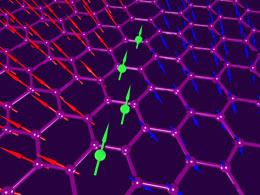 A flow of electrons (green arrows) magnetises graphene in the opposite directions to the left and to the right from the current flow.Science/A
A flow of electrons (green arrows) magnetises graphene in the opposite directions to the left and to the right from the current flow.Science/ASingle-atom carbon sheets could be ideal for spintronics. The ultra-thin form of carbon known as graphene has been hailed as a wonder material because of its exceptional electrical, thermal and mechanical properties. It now appears to have just the qualities needed to make ultra-fast electronic circuits that utilize the spin as well as the charge of electrons.Graphene is a layer of carbon one atom thick arranged in a hexagonal lattice. Discovered in 2004 by Andre Geim and Konstantin Novoselov of Manchester University, UK, who used sticky tape to remove slivers of graphite from pencil lead, its enormous strength, high thermal conductivity and unique electronic properties have spawned a huge amount of both fundamental and applied research and earned its discoverers the Nobel prize in physics last year. In the latest work, published today in Science, Geim and an international team of colleagues show that graphene could be used to make a new generation of so-called 'spintronic' devices. Conventional silicon chips encode binary data using the presence or absence of electric charge, but there is a limit to how small such chips can be made because of the heat generated by electrical currents. The idea of spintronics is to use not only electrons' charge but also their inherent angular momentum, or spin, which can be either 'up' or 'down'. That should yield devices that are smaller and faster, thanks to the fact that an electron's spin can be changed much more quickly than charge can flow round a circuit. Magnetic magicIn practice, however, it is difficult to build components that can simultaneously inject, manipulate and then read out currents based on electron spin. One way to do this is to combine semiconductors with magnetic materials, with the latter injecting spin-polarized currents into the former, but finding materials that are compatible with one another is extremely tricky. It would be better if the three-step process could be carried out in a single material. Graphene appears to fit that bill.Geim and colleagues passed an electric current between two electrodes placed about a millionth of a metre apart on a graphene sheet and then measured the voltage across a region of the sheet about ten millionths of a metre from the electrodes. In any other material, that voltage would be close to zero, because currents straying from the path between the two electrodes become progressively weaker the farther away they get. But the researchers found that when they applied a magnetic field across the graphene sheet there was in fact a significant voltage. This, they say, is evidence of spin currents. What they believe is happening is that the magnetic field creates an imbalance in the number of spin-up and spin-down electrons, because it becomes energetically favourable for more of one type to line up with the field. Conversely, the field creates an opposite imbalance in the spin of electron vacancies, or holes. At the same time, the magnetic field exerts a force on the electrons and holes, as it would on any current flowing through a conductor, pushing them away from the current path. Sensing spinTeam member Leonid Levitov at the Massachusetts Institute of Technology in Cambridge explains that because the electrons and holes are pushed in the same direction there is no net movement of charge, but because both types of carrier have the same spin (as a hole can be thought of as an anti-electron) then there is a flow of spin. And, he says, just as an electric current travelling in an antenna generates an electromagnetic field that can generate a current in another antenna some distance away, so too a spin-current generated from a voltage can return the favour and induce a new voltage far from the original.Levitov points out that their experiment does not provide direct proof that graphene can generate spin currents. But he maintains that he and his colleagues have analysed all other possible explanations and found them wanting. The practical applications of the work could be limited, Geim admits. Having to apply a magnetic field is a disadvantage, because it means that spintronic devices made of graphene could then be sensitive to unintended sources of magnetism. But he believes that graphene could yield much stronger and longer-lasting spin currents than other materials that naturally possess a spin-charge correlation and therefore do not require a magnetic field. David Awschalom of the University of California, Santa Barbara, who was not involved with the work, believes that the experimental results "unveil an intriguing mechanism for electrically driving spin transport in graphene". And he says that the technique "may have interesting applications within both sensing and spintronics". Reference: Graphene turns spin doctor(nature.com) |
No comments:
Post a Comment